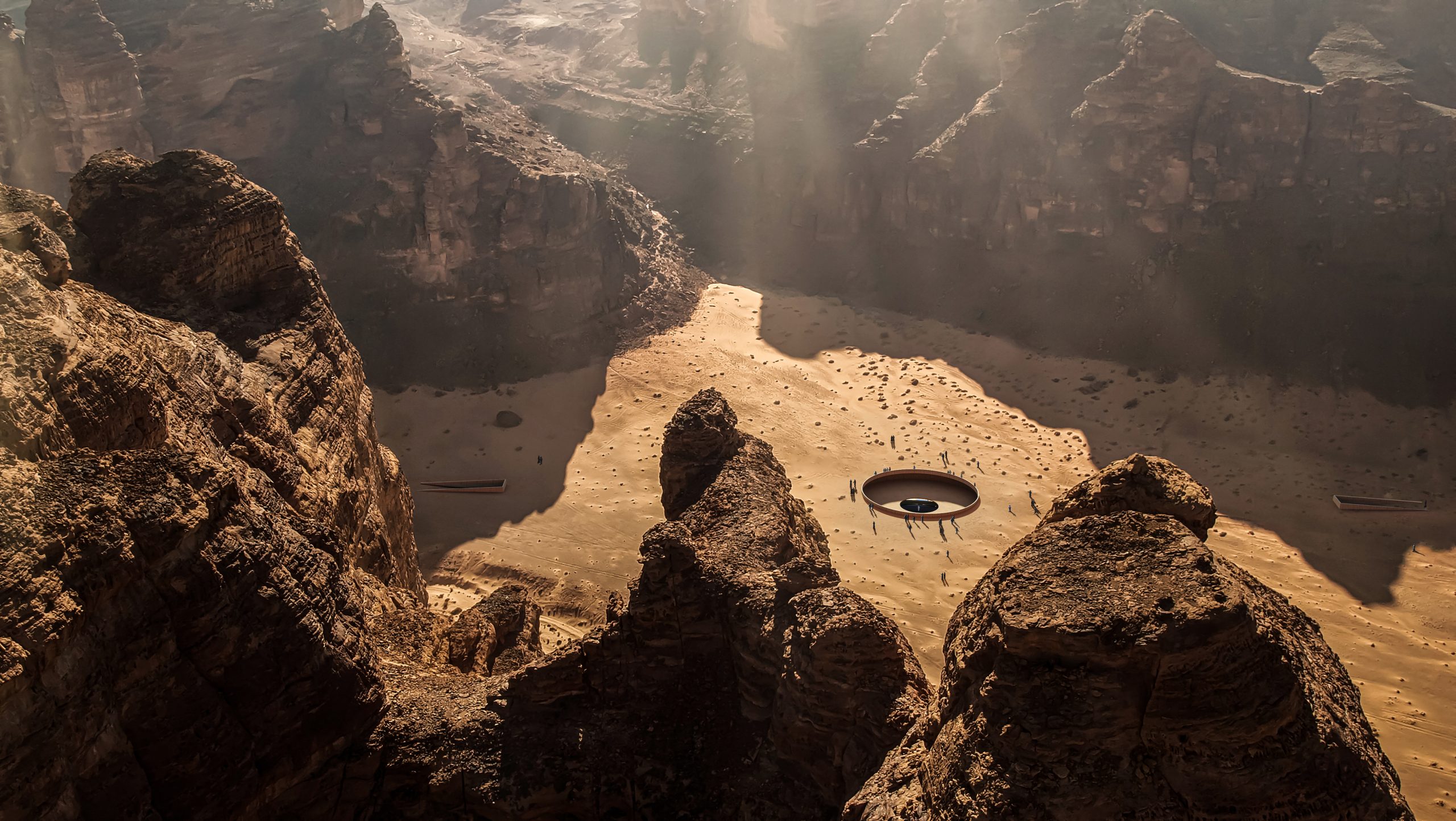
Land Art, associated with the 1960s, is witnessing a major resurgence in the Arabian Peninsula. A “Valley of the Arts”—Wadi AlFann in Arabic—is being created as part of a $15 billion AlUla masterplan to create a major cultural hub in Saudi Arabia.
Five permanent artworks are planned for Wadi AlFann, which will be unveiled in 2024—artists James Turrell, Agnes Denes, Michael Heizer, as well as Saudi artists Manal AlDowayan and Ahmed Mater have been tapped for the project. The pre-opening program launches late 2022 with temporary exhibitions, artist residencies, and public symposia that will bring artists together with architects, environmentalists, archaeologists, as well as local communities.
According to Nora AlDabal, executive director of arts and creative industries at the royal commision for AlUla, the aim is to commission between 20 and 25 permanent artworks over a period of 10 years. The new project will provide a counterpoint to Desert X AlUla, which has been staging temporary artworks at the same location since 2020.
Former head of Whitechapel Iwona Blazwick is leading the project as chair of the royal commission for AlUla’s public art expert panel. She stepped down from her longtime post in London earlier this year. “The geopolitical axis has moved,” Blazwick told Artnet News.
James Turrell. Courtesy James Turrell. Photo: Florian Holzherr.
Wadi AlFann lies within the Royal Commission’s remit of the so-called cultural manifesto for AlUla, a treaty created in 2018 to help open up the country to cultural tourism by protecting the region’s heritage, using locally sourced material and ensuring free movement of camel herds and protection of Indigenous flora. “We are working closely with local and international experts in archaeology, heritage conservation, and preservation to deliver environmentally and historically sensitive work,” said AlDabal.
The kingdom nevertheless faces criticism from international human rights activists in the wake of the murder of journalist Jamal Khashoggi; some have accused the country of culture-washing.
Since 2018, Blazwick has been visiting AlUla and advising on different aspects on Wadi AlFann, alongside art advisor Allan Schwartzman, who is a member of the advisory board for the Royal Commission of Al-Ula. Eventually, Blazwick was invited by the royal commission to become more involved. “We are in a different geological phase of the planet here in AlUla,” she said during a small on-site press conference announcing the project in earlier in June. “The biggest sculpture in AlUla’s desert is of course the wind… What we will see over the years is the evolution of monumental works which will be permanent, site-specific artworks inscribed by the desert itself.”
Render of Ashab Al-Lal by Ahmed Mater at Wadi AlFann. Courtesy of ATHR Gallery.
A New Vision for Land Art
Wadi AlFann marks the first time Land Art pioneers are being paired with a younger generation of Saudi Arabian artists. The outdoor gallery will span approximately 65 kilometers (40 miles) of AlUla’s desert landscape.
A helicopter ride over the location reveals its 12-century old town comprising abandoned villages amid pockets of green. “These monuments are given context by AlUla’s countless inscriptions and rock art. Through contemporary art projects in AlUla, we want to tap into the art and culture of those who came before us,” AlDabal told Artnet News.
This will be the focus of Manal AlDowayan’s work, Oasis of Stories. The artist is inviting local residents to inscribe their stories on clay tablets which will be cast on walls made out the waste that results from desalination. In a collaboration with Wael Awar of Waiwai architects, winners of the 2021 Venice Architectural Biennale’s Gold Lion, her environmentally sensitive installation will take the form of an immersive labyrinth evocative of ancient settlements in the area.
“Historically, the Dadanites and the Nabateans left their stories in engravings on the walls,” AlDowayan said in an interview. Her work often address the politics of invisibility in relation to women. “What are the stories of the new custodians, their descendants, the people of AlUla? What does AlUla’s transformation mean to the locals who are now our hosts?” she added.
Sketches for The Oasis of Stories by Manal AlDowayan, for Wadi AlFann
Agnes Denes will expand on her pyramid series through an examination of AlUla’s sandstone rock and Michael Heizer’s work will draw from their engravings. For his part, Turrell is planning four of his so-called “Skyspaces,” including a series of underground pathways within the canyon. “I am interested in where the light inside—the light of the lucid dream—meets the so-called light outside,” Turrell told Artnet News in an interview. “Our reality is formed by our perception, and this is the reality within which we live.“ He added that one of humanity’s biggest conceits “is that we feel ourselves apart from nature.”
Saudi artist Ahmed Mater, inspired by the significance of the mirage in nomadic cultures, the astrolabes of the Golden Age of Islam, and Ḥasan Ibn al-Haytham’s study of optics, will create a triangular shaped walkthrough tunnel. Using parabolic mirrors, the work, called Ashab Al-Lal, will reflect the viewer’s body and AlUla’s sandstone cliffs rising like a hologram. “We will become the dream, the mirror, the image of ourselves,” Mater told Artnet News.
His vision for this interactive work is currently being exhibited at Athr Gallery’s new branch in AlUla (the gallery has another location in Jeddah).
“This is not a sculpture park,” Blazwick said. “Each work has to withstand powerful forces of wind, sand, people, and animals for posterity.” She added that works will be immersive, phenomenological, and evoke “a kind of secular spirituality” that contributes to the stories of the communities in the region.